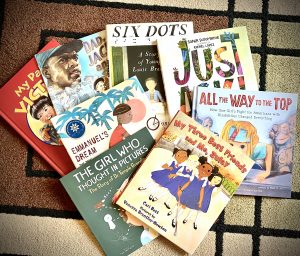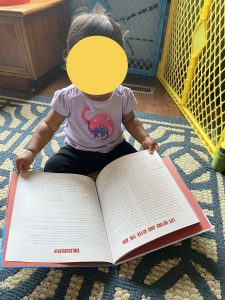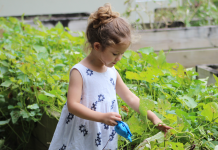Ableism is the discrimination – intentional or unintentional- against people with a
disability. It surrounds us whether we realize it or not.
Part of raising good humans includes fostering anti-ableism in our children. To do this, we need to:
- Recognize what disability is (and what it is not).
- Understand that disability is not a flaw or something to be fixed.
- Feel comfortable interacting with people with disabilities and doing so in a way that is respectful and appropriate.
- Recognize their role in advocating for access and inclusion.

Over the next few months, I’m going to share some different ways we can work towards this. I’ll talk about raising awareness, being mindful of the words we use, and having conversations about disability with our kids. Like anything, this is an ongoing process and not something that happens overnight. Engaging in anti-ableism work is something we have to choose to do every day.
Raising Awareness: Read Disability-Inclusive Books

Disability comes in many shapes, sizes, and forms. One of the simplest ways to teach kiddos about disability is through books. The more disability-inclusive books you read, the wider variety of disability you’ll expose them to. Try to read disability-inclusive books that are diverse. We want to fight against ableism for all people, not just disabled people who look, talk, and act like us. Here are some of my favorite disability-inclusive picture books:
My Pal, Victor by Diane Gonzales Bertrand
Victor, a wheelchair user, and Dominic are best friends who enjoy doing lots of things together. Each likes the other just the way they are.
Dad, Jackie, and Me by Myron Uhlberg
In this story, the main character and his Deaf father bond over a shared love of baseball. They enjoy going to as many games as they can and cheering for Jackie Robinson, their favorite player.
Emmanuel’s Dream by Laurie Ann Thompson & Sean Qualls
This is the true story of Emmanuel Ofosu Yeboah, a Ghanian cyclist and disability advocate. He was born without a tibia in his right leg and has dedicated his life to raising awareness and advocating for accessibility and inclusion.
My Three Best Friends and Me, Zulay by Cari Best
Zulay, a Blind first grader, competes in her school Field Day. In order to make that happen, she and her teacher work together to help her do so safely.
All The Way to the Top by Annette Bay Pimentel
This is the true story of Jennifer Keelan. As a young girl, she participated in the Capitol Crawl, a protest in support of the Americans with Disability Act (ADA). The Crawl is often credited with convincing Congress to pass the ADA in 1990.
Just Ask! by Sonia Sotomayor
This story is about a group of children who work together to create a community garden, each with different strengths and needs that make them unique. I love the wide range of disabilities and health conditions represented.
She Persisted in Sports by Chelsea Clinton
Part of the She Persisted series, this book includes stories of American female Olympians, including Jean Driscoll, a record-setting wheelchair racer.
Hello Goodbye Dog by Maria Gianferrari
This book is about the relationship between a girl (Zara) and her dog (Moose) and is utterly delightful. Zara uses a wheelchair, but disability is not the main focus of the book.
The William Hoy Story by Nancy Churnin
This book is about William Hoy, one of the first major league baseball players with a disability. He helped make baseball a more accessible sport for Deaf individuals through the introduction of the hand signals still used by umpires today.
Note: There is some problematic language in this one, so be aware when reading it. He was known as William “Dummy” Hoy, which is not an okay nickname to give someone. However, his contributions to baseball and accessibility are incredibly important. For this reason, I still wanted to include it in this list. It’s a good reminder of the historical (and ongoing) stigmatizing language used to describe people with disabilities. Words matter, and we’ll talk more about this in a future article.
A Boy and A Jaguar by Alan Rabinowitz
Alan Rabinowitz is an American zoologist who devoted his life to the study and protection of wild cat species. Growing up with a stuttering condition, he was always most comfortable when talking to animals.
The Girl Who Thought in Pictures by Julia Finley Mosca
This is the true story of Dr. Temple Grandin, a world-renowned animal behavior scientist with autism.
Note: While I love this book, it does have a couple spots with problematic language, including the phrase “a shy loner.” To address that when I read it to my kiddo, I just say “a shy girl” and talk about other ways we can talk about people who like to be on their own.
Rescue & Jessica by Jessica Kensky and Patrick Downes
This is the true story of Jessica Kensky, a survivor of the Boston Marathon bombing, and her service dog. Jessica had amputations on both her legs, because of injuries sustained in the bombing.
Note: If reminders of the marathon bombing are triggering or uncomfortable for you, you may want to pass on this one.
Six Dots by Jen Bryant
This is the story of Louis Braille, who created the Braille lettering system when he was a teenager. After losing his sight as a child, he missed being able to read his books. By developing the Braille system, he was able to do so again.
This list is by no means exhaustive, but these are some of our favorites. I encourage you to check out a few this summer.










